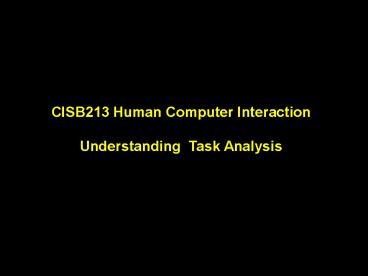CISB213 Human Computer Interaction Understanding Task Analysis - PowerPoint PPT Presentation
1 / 18
Title:
CISB213 Human Computer Interaction Understanding Task Analysis
Description:
CISB213 Human Computer Interaction Understanding Task Analysis * Learning Outcomes At the end of this lecture, you should be able to: Draft the Hierarchical Task ... – PowerPoint PPT presentation
Number of Views:239
Avg rating:3.0/5.0
Title: CISB213 Human Computer Interaction Understanding Task Analysis
1
CISB213 Human Computer InteractionUnderstanding
Task Analysis
2
Learning Outcomes
- At the end of this lecture, you should be able
to - Draft the Hierarchical Task Analysis (chart or
textual based)
3
Key Terms you must be able to use
- If you have mastered this topic, you should be
able to use the following terms correctly in your
assignments and exams - Task analysis
- Hierarchical task analysis
4
Task Analysis
- A method/set of methods for understanding the
tasks users carry out with a product/system - To analyze the underlying rationale and purpose
of what people are doing what are they trying to
achieve, why are they trying to achieve it, and
how are they going about it? - To investigate an existing situation
- Can be used for many different purposes within
design and evaluation activities.
5
Task Analysis
- Key definitions (Norman, 1988)
- Goal - the state that the human wishes to
achieve - Task - the activity required in order to bring
about the state the human wishes to achieve (the
goal)
6
Task Analysis
- Task analysis techniques support user-centred
design - Informs us (in detail) as to
- how users use existing products
- how users may interact with future products
- Can be used to
- improve current design
- identify potential problems with new design
- identify requirements for new design
- design training materials and manuals
- develop evaluation plans
7
Hierarchical task analysis
- HTA is a commonly used means of breaking tasks
down into a hierarchy of goals, operations
(actions) and plans - It involves breaking a task down into subtasks
and then into sub subtasks - These are then grouped together as plans that
specify how the tasks might be performed in an
actual situation
8
Procedure for carrying out Hierarchical task
analysis
- The starting point is a user goal, then examined
the main tasks associated with achieving that
goal. Where appropriate, these tasks are
subdivided into subtasks - Start with the overall goal (verb-noun pair),
e.g. Use email, Print a letter - Break these down into meaningful subgoals/tasks
(asking how question) - Break down subgoals further until reach an
appropriate stopping point
9
Procedure for carrying out Hierarchical task
analysis
- Add plans to the analysis - conditional
statements, often utilising boolean logic, e.g. - DO 1, THEN 2, THEN (IF condition true) DO 3,
ELSE DO 4, THEN EXIT - Represent the goals, subgoals, operations and
plans using either - graphical views (boxes and arrows)
- non-graphical methods (e.g. tabulation,
outlines, textual)
10
Hierarchical task analysis graphical view
11
Hierarchical task analysis graphical view
12
Hierarchical task analysis textual
representation
- HTA can also be written as a list like this
- 0. to clean house
- 1. get vacuum cleaner
- 2. clean rooms
- 2.1 clean hall
- 2.2 clean living rooms
- 2.3 clean bedrooms etc
- 3. empty dust bag
- 4. put vacuum cleaner away
- Plan 0 do 1,2,4
- when dust bag full, do 3
- Plan 2 do any of 2.1, 2.2, 2.3 in any order
depending on which rooms need cleaning.
13
An example of HTA for a Microwave Oven
- What is the overall goal?
- Cook food!
- How is this done?
- Prepare meal
- Put meal in oven
- Select programme
- Listen for bell to ring
- Remove meal
14
An example of HTA for a Microwave Oven
- Selecting a programme - How is this done?
- Set to autosensor
- Set to defrost
- Set timer to cook
- What are the rules that influence the order in
which tasks/subtasks take place? (the plans)..
15
An example of HTA for a Microwave Oven
16
Further Task Analysis (Matrixes)
17
Task Analysis Critical Thinking
- Some requirements that might have emerged from
carrying out this Task analysis - The need for a distinctive, but not annoying,
bell sound - The need for an easily accessible mechanism for
opening the door - The need for a highly learnable (guessable) means
of selecting a programme
18
Q A































